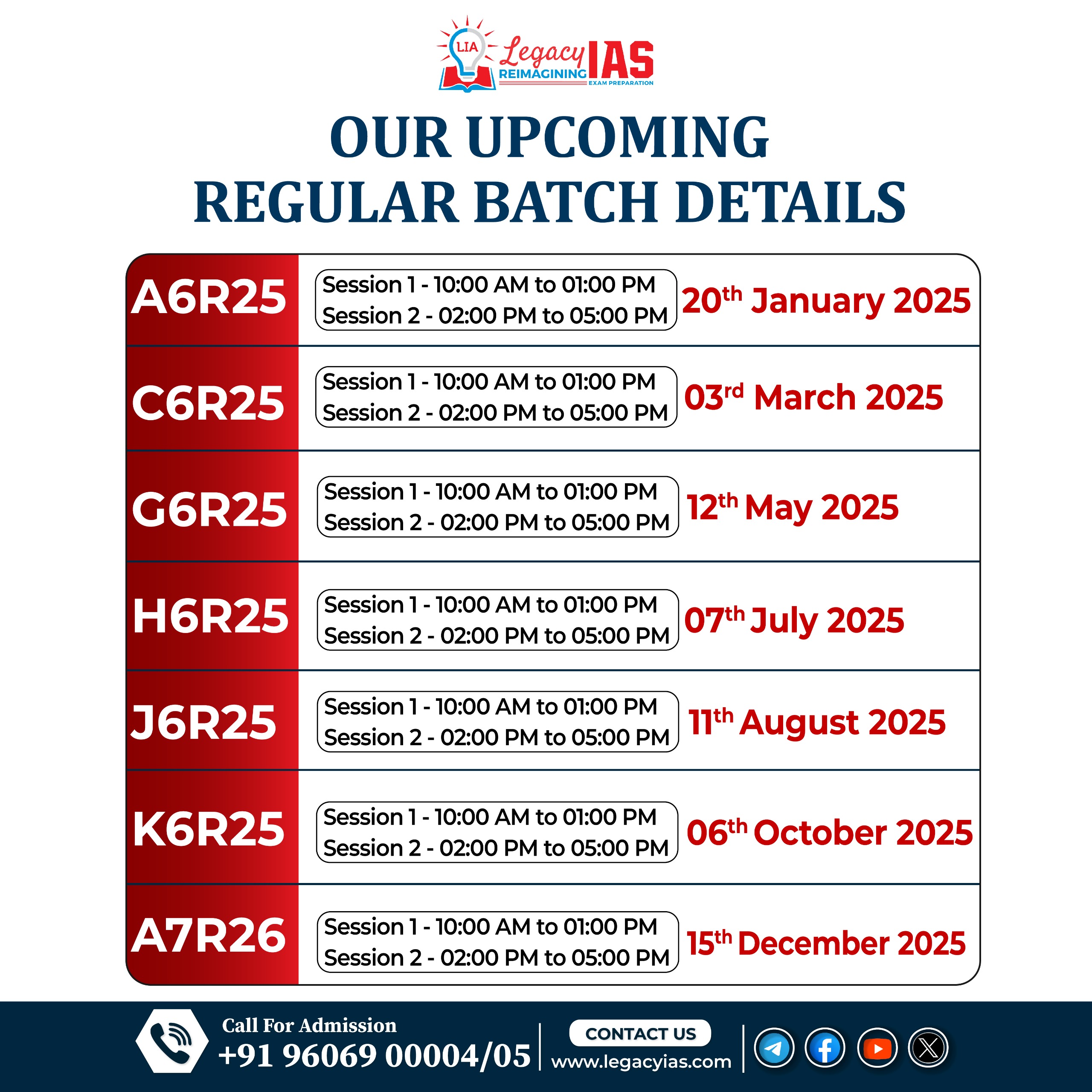Content:
- National Geospatial Policy 2022
- National Science Day 2025
National Geospatial Policy 2022
Introduction & Context
- Notified on: December 28, 2022
- Vision: Position India as a global leader in geospatial technologies by 2035
- Key Themes: Liberalization, democratization of geospatial data, innovation, and self-reliance
- Institutional Framework: Led by the Department of Science and Technology (DST)
- Significance:
- Enables open access to geospatial data generated with public funds
- Develops geospatial infrastructure, services, and platforms at national & sub-national levels
- Supports economic growth, governance, and technological advancements
Relevance : GS 3(Science and Technology )
Budgetary Allocations & Trends (Union Budget 2025-26)
- ₹100 crore allocated for the National Geospatial Mission
- Focus on foundational geospatial infrastructure and modernization of land records
- Integration with PM Gati Shakti for seamless planning and execution of infrastructure projects
- Public-Private Partnerships (PPPs):
- Enhanced access to geospatial data from PM Gati Shakti portal for private sector collaboration
- Aims to streamline infrastructure development and investment planning
Key Focus Areas of National Geospatial Policy 2022
- Geospatial for Transformation & SDGs:
- Supports UN Sustainable Development Goals (SDGs) through spatial data-driven governance
- Atmanirbhar Bharat & Self-Reliance:
- Strengthening India’s domestic geospatial ecosystem to reduce dependence on foreign data sources
- Global Best Practices & IGIF:
- Adopts UN Integrated Geospatial Information Framework (IGIF) for standardization
- Robust Geospatial & ICT Infrastructure:
- Promotes data interoperability, custodianship models, and real-time accessibility
- Fostering Innovation & Startups:
- Encourages R&D, AI integration, and geospatial startup ecosystem
- Standards & Interoperability:
- Promotes open standards, compliance frameworks, and seamless integration
- Capacity Development & Education:
- Includes geospatial education in school & higher education curricula
- Ease of Doing Business:
- Reduces regulatory barriers for private sector investment in geospatial technologies
- Democratization of Data:
- Survey of India (SoI) datasets to be publicly accessible
Geospatial Policy Under PM Gati Shakti
- Alignment with PM Gati Shakti – National Master Plan for Multi-modal Connectivity
- Integration of 16 key Ministries (Railways, Highways, Shipping, etc.) for synchronized infrastructure planning
- Utilization of ISRO & BiSAG-N spatial planning tools
- Objectives:
- Reduce infrastructure redundancies
- Optimize transport & logistics planning
- Improve last-mile connectivity & reduce travel time
- Real-time geospatial data usage:
- Enhancing decision-making for infrastructure development projects
- Minimizing delays & cost overruns
National Geospatial Data Repository (NGDR): A Centralized Data Hub
- Purpose:
- Acts as a one-stop platform for geospatial data management and sharing
- Ensures data interoperability across government, academia, and private sector
- Benefits:
- Supports governance, economic development, and digital transformation
- Facilitates evidence-based policymaking
Empowering Inclusion & Progress Through Geospatial Data
- Wider Access to Location-based Intelligence:
- Benefits rural & remote communities by integrating them into development planning
- Strengthening Self-reliance (Atmanirbhar Bharat):
- Empowers Indian companies to develop indigenous geospatial capabilities
- Enhances global competitiveness in geospatial technologies
- Government Support:
- DST is liberalizing data access to foster innovation and entrepreneurship
- Future Scope:
- Expanding geospatial policy applications in climate resilience, agriculture, and smart city planning
National Science Day 2025
Introduction
- National Science Day (NSD) is celebrated annually on 28th February to honor the discovery of the Raman Effect by Sir C.V. Raman in 1928.
- He was awarded the Nobel Prize in Physics in 1930 for this discovery.
- First observed in 1987, it has become a key platform for promoting scientific awareness.
- Theme for 2025: “Empowering Indian Youth for Global Leadership in Science & Innovation for VIKSIT BHARAT.”
- Aligns with Viksit Bharat 2047 vision of a developed and self-reliant India.
- Focuses on harnessing youth potential in science & technology.
Relevance : GS 3(Science and Technology)
Objectives of National Science Day
- Spreading Awareness
- Highlights the significance of science and technology in daily life.
- Showcasing Achievements
- Displays India’s scientific progress and contributions.
- Discussing Future Innovations
- Platform for addressing scientific challenges and technological advancements.
- Encouraging Scientific Temper
- Promotes scientific curiosity and fosters a research-driven mindset.
Key Scientific Achievements (2024 Highlights)
1. India’s Global Standing in Science & Technology
- Ranked 39th in the Global Innovation Index 2024.
- Ranked 6th in global Intellectual Property (IP) filings (WIPO report).
- Network Readiness Index (NRI) 2024: India climbed from 79th (2019) to 49th (2024).
2. Anusandhan National Research Foundation (ANRF)
- Established under the ANRF Act 2023 to boost R&D.
- Key Initiatives:
- PM Early Career Research Grant (PMECRG) – Supports young researchers.
- EV Mission – Promotes electric vehicle innovation.
- Partnerships for Accelerated Innovation and Research (PAIR) – Encourages institutional collaborations.
- Inclusivity Research Grant (IRG) – Supports SC/ST researchers.
3. National Quantum Mission (NQM)
- Budget: ₹6003.65 crore (8-year plan).
- Aims to advance quantum computing, communication, sensing, and materials.
- 152 researchers from 43 institutions working across 17 states & 2 UTs.
- Supports quantum startups via funding & mentorship.
4. National Supercomputing Mission (NSM)
- Expanded India’s supercomputing power to 32 PetaFlops.
- Largest supercomputer (3 PetaFlops) at IUAC, New Delhi.
- Future goal: 77 PetaFlops using indigenous technology.
5. Artificial Intelligence & Cyber-Physical Systems
- BharatGen Initiative: India’s first multilingual Large Language Model (LLM) for Generative AI.
- I-HUB Quantum Technology Foundation (IISER Pune):
- Funded 8 startups for quantum innovation.
- Plans to upgrade 4 top-performing Technology Innovation Hubs (TIHs) into Technology Translation Research Parks (TTRPs).
6. Geospatial Science & Innovation
- Spatial Thinking Programs introduced in 116 schools (7 states), benefitting 6205 students.
- Training in geospatial science: 575 participants through Summer/Winter Schools.
- Future expansion to 5 more states.
7. Climate Research & Disaster Risk Mapping
- 4 new Centres of Excellence launched for flood & drought risk mapping.
- Focus on climate resilience & disaster preparedness.
8. Technology Development Board (TDB)
- ₹220.73 crore funding across 7 projects to support startups and research.
INSPIRE Program: Nurturing Scientific Talent
- Flagship initiative by the Department of Science & Technology (DST).
- Encourages youth participation in science & innovation.
Key 2024 Achievements:
- 34,343 INSPIRE Scholars, 3363 INSPIRE Fellows, 316 INSPIRE Faculty Fellows received research grants.
- 9 INSPIRE Fellows participated in JSPS-HOPE Meeting, Kyoto, Japan.
- 11th National Level Exhibition & Project Competition (NLEPC) held in Pragati Maidan, New Delhi.
- INSPIRE-MANAK program: Over 1 million student entries in 2024-25.
- New Initiative: Japanese school students visited India to study Indian advancements in science & technology.
- Future Vision: Expanding INSPIRE-MANAK to Class 11 & 12 students.
Bridging the Gender Gap in Science
- WISE-KIRAN Scheme (Women in Science & Engineering-KIRAN):
- WISE-PhD & WISE-PDF – Supports women researchers in STEM.
- WINGS (Women’s International Grants Support) – Facilitates research training in international labs.
- Women Leadership Program – Supports early/mid-career women scientists.
- Vigyan Jyoti Program:
- Encouraged 29,000+ girls (Class IX-XII) to take up STEM careers.
- CURIE (Consolidation of University Research for Innovation and Excellence) Program:
- 22 Women PG Colleges received research infrastructure.
India’s Legacy in Science
- Ancient India made remarkable contributions:
- Mathematics: Decimal system, concept of zero.
- Metallurgy: Wootz steel, zinc extraction.
- Astronomy & Medicine: Aryabhata’s work, Ayurveda.
- This heritage continues to drive India’s scientific growth & innovation.





